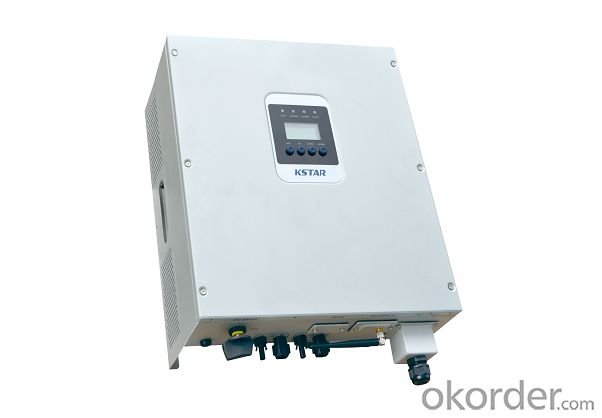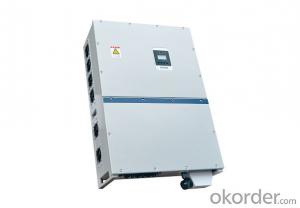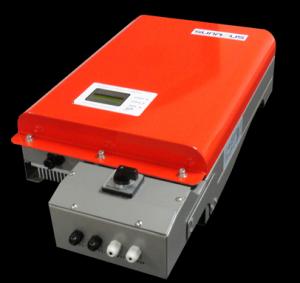Tesla Solar Inverter Price - String Grid-Tied PV Inverter 30KW / 50KW / 60KW
- Loading Port:
- Guangzhou
- Payment Terms:
- TT OR LC
- Min Order Qty:
- 10 unit
- Supply Capability:
- 10000 unit/month
OKorder Service Pledge
OKorder Financial Service
You Might Also Like
String Grid-Tied PV Inverter 30KW / 50KW / 60KW
Product features
· Max PV Voltage up to 1000V
· Three MPPT
· High efficiency up to 98.6%
· IP65 protection
· Easy installation
· Reactive power controller
· Digital controller
Product Parameter
Q 1. what's the payment term?
A. We accept TT,30% deposit and 70% balance agaisnt copy of BL
Q 2. how's the delivery time ?
A. usually it will take about 25 days for production
Q 3. tell me the standard of package?
A. For the small capacity, it use carton, but for big capacity, we will use strong wooden case for protection.
Q 4. what kind of material of transformer?
A. we have two types, one 100% copper and the other is copper with aluminum.It depends on your requirment. In fact,those two have no difference if normal work well. Only except the longlife. Copper is better and also higer price.
Q 5.Could you offer Form A or C/O ?
A. It totally not a problem. We can prepare relative documents to forgin affairs office or other office to apply for this certificate.






- Q: Can a solar inverter be used with solar trackers?
- Yes, a solar inverter can be used with solar trackers. Solar trackers are used to maximize the efficiency of solar panels by orienting them towards the sun. Solar inverters are responsible for converting the DC power generated by solar panels into usable AC power. Both components work together to optimize solar energy production.
- Q: What is the typical installation process for a solar inverter?
- The typical installation process for a solar inverter involves several steps. First, a suitable location for the inverter is identified, usually near the solar panels. The inverter is then mounted securely on a wall or other structure. Next, the DC wiring from the solar panels is connected to the input terminals of the inverter, ensuring proper polarity. The AC output terminals of the inverter are then connected to the electrical panel of the building, often through a dedicated circuit breaker. Finally, the inverter is connected to the monitoring system to track its performance and ensure optimal energy production. It is important to follow the manufacturer's instructions and consult a professional electrician to ensure a safe and efficient installation.
- Q: How does a solar inverter handle variations in grid frequency?
- A solar inverter handles variations in grid frequency by continuously monitoring the frequency of the grid and adjusting its output accordingly. It is designed to synchronize with the grid frequency and maintain a stable and consistent output, even when the grid frequency fluctuates. This helps to ensure that the solar energy generated is efficiently fed into the grid, without causing any disruption or damage to the inverter or the grid itself.
- Q: What is the importance of overcurrent protection in a solar inverter?
- Overcurrent protection is of utmost importance in a solar inverter for several reasons. Firstly, solar inverters are responsible for converting the direct current (DC) generated by solar panels into alternating current (AC) that can be used to power electrical devices. During this conversion process, there is a risk of an overcurrent situation occurring, where the current flowing through the inverter exceeds its rated capacity. This can lead to overheating, damage to the inverter components, and even fire hazards. Secondly, overcurrent protection ensures the safety of the entire solar power system. By detecting and interrupting the flow of excessive current, it prevents damage to the solar panels, the inverter, and other connected electrical equipment. It also safeguards against electrical shocks and other potential hazards that could arise from an overcurrent situation. Furthermore, overcurrent protection plays a crucial role in maintaining the efficiency and performance of the solar inverter. When an overcurrent event occurs, the inverter can shut down or reduce its output to prevent further damage. This helps to avoid unnecessary downtime and ensures that the solar power system continues to operate at its optimum capacity. Moreover, overcurrent protection is essential for meeting regulatory and safety standards. Many countries and regions have specific guidelines and requirements regarding the installation and operation of solar power systems. Compliance with these standards is necessary to ensure the safety of personnel, protect the environment, and prevent any legal or financial liabilities. In conclusion, overcurrent protection in a solar inverter is critical for the safety, efficiency, and performance of the entire solar power system. It prevents damage to the inverter and other equipment, safeguards against hazards, and ensures compliance with regulatory standards. Therefore, it is essential to implement reliable and effective overcurrent protection mechanisms in solar inverters.
- Q: What is the difference between a PV grid-connected inverter and an off-grid inverter?
- Offline generally need energy storage, not to send energy online. Power grid has no right to interfere.
- Q: What is the maximum output power of a solar inverter?
- The maximum output power of a solar inverter depends on its capacity and rating. It can range from a few hundred watts for residential inverters to several megawatts for commercial or utility-scale inverters.
- Q: Can a solar inverter be used in a hybrid solar system?
- Yes, a solar inverter can be used in a hybrid solar system. A hybrid solar system combines both solar power and another source of energy, such as a battery or grid power. The solar inverter is responsible for converting the DC power generated by the solar panels into AC power that can be used in the home or fed back to the grid. In a hybrid solar system, the solar inverter would still perform this function, allowing the system to utilize both solar and other energy sources efficiently.
- Q: How does the input voltage range affect the performance of a solar inverter?
- The input voltage range directly affects the performance of a solar inverter. A wider input voltage range allows the inverter to accommodate a greater variety of solar panel configurations and fluctuations in solar energy production. This flexibility ensures optimal operation and increased energy conversion efficiency, resulting in better overall performance. On the other hand, a narrow input voltage range restricts the inverter's compatibility and may lead to reduced efficiency and output power.
- Q: Can a solar inverter be used with a solar-powered heating system?
- Yes, a solar inverter can be used with a solar-powered heating system. The solar inverter converts the direct current (DC) generated by the solar panels into alternating current (AC) which can be used to power various appliances, including a heating system. This allows the solar panels to provide clean and renewable energy for heating purposes.
- Q: Can a solar inverter be used in systems with different module types?
- Yes, a solar inverter can be used in systems with different module types. Solar inverters are designed to convert the direct current (DC) generated by solar panels into alternating current (AC) that can be used to power electrical devices. They are compatible with various module types, such as monocrystalline, polycrystalline, and thin-film solar panels, allowing them to be used in diverse solar energy systems.
Send your message to us
Tesla Solar Inverter Price - String Grid-Tied PV Inverter 30KW / 50KW / 60KW
- Loading Port:
- Guangzhou
- Payment Terms:
- TT OR LC
- Min Order Qty:
- 10 unit
- Supply Capability:
- 10000 unit/month
OKorder Service Pledge
OKorder Financial Service
Similar products
Hot products
Hot Searches
Related keywords






























